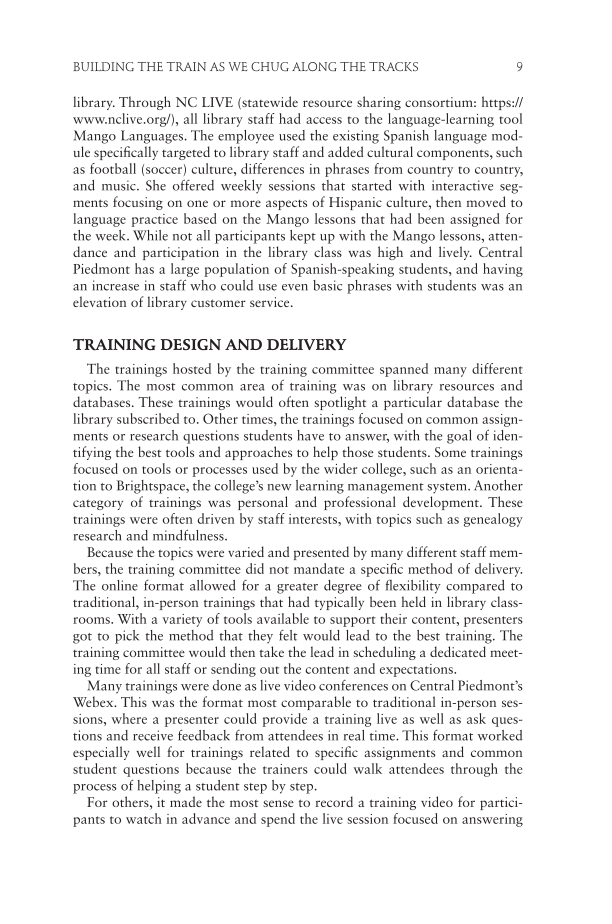Building the Train as We Chug Along the Tracks 9 library. Through NC LIVE (statewide resource sharing consortium: https:// www.nclive.org/), all library staff had access to the language-learning tool Mango Languages. The employee used the existing Spanish language mod- ule specifically targeted to library staff and added cultural components, such as football (soccer) culture, differences in phrases from country to country, and music. She offered weekly sessions that started with interactive seg- ments focusing on one or more aspects of Hispanic culture, then moved to language practice based on the Mango lessons that had been assigned for the week. While not all participants kept up with the Mango lessons, atten- dance and participation in the library class was high and lively. Central Piedmont has a large population of Spanish-speaking students, and having an increase in staff who could use even basic phrases with students was an elevation of library customer service. TRAINING DESIGN AND DELIVERY The trainings hosted by the training committee spanned many different topics. The most common area of training was on library resources and databases. These trainings would often spotlight a particular database the library subscribed to. Other times, the trainings focused on common assign- ments or research questions students have to answer, with the goal of iden- tifying the best tools and approaches to help those students. Some trainings focused on tools or processes used by the wider college, such as an orienta- tion to Brightspace, the college’s new learning management system. Another category of trainings was personal and professional development. These trainings were often driven by staff interests, with topics such as genealogy research and mindfulness. Because the topics were varied and presented by many different staff mem- bers, the training committee did not mandate a specific method of delivery. The online format allowed for a greater degree of flexibility compared to traditional, in-person trainings that had typically been held in library class- rooms. With a variety of tools available to support their content, presenters got to pick the method that they felt would lead to the best training. The training committee would then take the lead in scheduling a dedicated meet- ing time for all staff or sending out the content and expectations. Many trainings were done as live video conferences on Central Piedmont’s Webex. This was the format most comparable to traditional in-person ses- sions, where a presenter could provide a training live as well as ask ques- tions and receive feedback from attendees in real time. This format worked especially well for trainings related to specific assignments and common student questions because the trainers could walk attendees through the process of helping a student step by step. For others, it made the most sense to record a training video for partici- pants to watch in advance and spend the live session focused on answering
Document Details My Account Print multiple pages
Print
You have printed 0 times in the last 24 hours.
Your print count will reset on at .
You may print 0 more time(s) before then.
You may print a maximum of 0 pages at a time.













































































































































































































































































